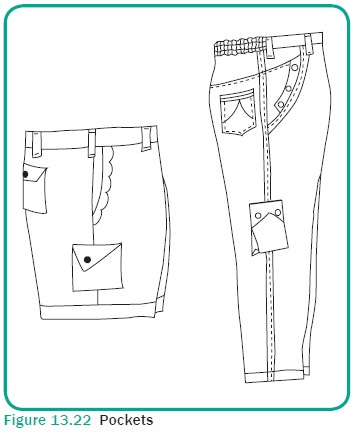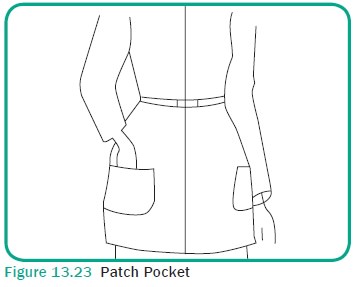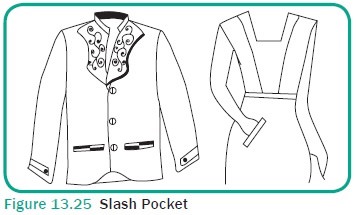Sewing Garment - Pockets | 11th Textiles and Dress Designing : Chapter 13 : Sewing Garment Details
Chapter: 11th Textiles and Dress Designing : Chapter 13 : Sewing Garment Details
Pockets
POCKETS
Introduction
The word pocket is derived from French word
“Poque”. It means a bag which is stitched on clothing. Pockets can be
func-tional or decorative. Functional pockets are used to hold small item or
valuable things. Decorative pockets add beauty to apparel. There are various
types of pock-ets used in girls, boys, men and women garments. A pocket can be
stitched like a patch, attached in a seam or made by altering a slit on a
garment and sewn (Figure 13.22).

Types of Pockets
Pockets can be divided into three types namely
patch pockets, inseam pockets and slash pockets.
Patch Pocket
Patch pocket is a simple pocket and it is sewn
like a patch on to a garment. Patch pocket has an opening on the top. This
pocket is very common on men’s shirts. For kids garment, the pocket can be
stitched in shapes of square or triangle or as cartoon motits. Laces, piping,
embroidery can also be used for decorative purposes. It can be stitched with
lining cloth or without lining. It can also be made with decorative fabrics. A
lining is needed for fabrics that stretch or sag. Fabrics that are firm enough
to hold their shape can be stitched without a lining (Figure 13.23).

Method of Sewing a Patch Pocket:
·
Turn under top edge of pocket hem line on the
right side of the fabric and stitch.
·
Stay stitch around the pocket on seam line,
beginning at fold line of the hem.
·
Trim the extra material, turn hem right side out
and press.
·
Fold in seam allowances along stitching and
press. Square corners must be mitered, rounded corners must be notched.
·
Stitch the edge of the hem to the pocket by hand
or top stitch from right side using machine.
·
Pin the pocket to the garment, slip stitch around
the pocket by hand or top stitch edges in place. Reinforce corners by back
stitching or by stitching a small triangle or square. Both the top corners of
the pockets must be reinforced properly to add strength.
Inseam Pocket
In seam pockets are sewen along the side seams of
the garment. These pockets are made on the left side of the garment. These
pockets are generally stitched in boy’s shorts, girl’s pant, pajama and kurtas.
It can be cut as part of the garment front and back or it can be cut from a
separate pattern piece and stitched to the seam. If the outer fabric is bulky
or heavy, the pocket pieces can be cut from lining fabric (Figure 13.24).

Method of Sewing Inseam Pockets
·
Take two pairs of pocket pieces in the main
fabric or plain fabric.
·
Finish all the edges of pocket
pieces.
·
Stitch pocket pieces to front and back opening,
right sides together. Press seam allowances toward pocket pieces.
·
Pin the garment front and the gar-ment back,
matching at seam line and pocket.
·
Stitch directionally along seam and around pocket
in one step. Use reinforcement stitches. Press seam allowance flat.
·
Turn the pocket toward the front of the garment.
Piping material would be effective. Buttons may be fixed in groups to create
design interest.
·
Seams can be finished if necessary.
Slash Pocket
Slash pocket is a pocket suspended on the wrong
side of the garment. A finished slit is seen on the right of the garment. It
serves as pocket opening. There are three types of slash pockets namely, bound
pocket, welt pocket and flap pocket.
·
In bound pocket the edges are slashed and
finished with binding. This is even in width.
·
In case of welt pocket the binding are wider at
the front, extending above the pocket opening.
·
There is a flap attached over the bound or welt
pocket. This is called flap pocket (Figure 13.25).

Method of Sewing a Slash Pocket
·
Cut along line on the front garment pattern.
·
Cut fabric pieces as per slash pocket.
·
Alter front piece of the garment as per the
pocket slant.
·
Place the right side of the pocket on the right
side of the garment.
·
Stitch along a seam line and press seam
allowance.
·
Fold pocket facing the wrong sides, finish the
bottom hem line with a row of stitching.
·
Flip the pocket back to bring the right side of
the pocket out.
·
Stitch pocket to front panel of the garment.
·
Press neatly.
Summary
Pockets are one part of the garment which is
functional and decorative. It adds inter-est to the garment especially in
children dresses. The different type of pockets is patch, inseam and slash
pockets. Slash pockets are further sub divided into bound, welt and flap
pockets. Pockets can also be used to hide some defects in the garment. Most of
the formal wears are designed with functional pockets.
POINTS TO REMEMBER
·
Pockets are sewn separately and then stitched to
the garment.
·
Pockets are constructed on kids, ladies and men’s
garments.
·
Pockets are used for functional and decorative
purposes.
·
Pockets vary in size, shape, and design. They can
be constructed using printed or contrast coloured materials to bring variations
in children’s garments.
·
The different types of pockets are patch, inseam
and slash pockets.
ACTIVITIES FOR THE TEACHER
·
To show different types of pocket.
·
To show different design and decoration of
pockets using power point.
ACTIVITIES FOR STUDENTS
·
To draw pocket styles and prepare patterns.
·
To stitch different styles of pockets.
Related Topics